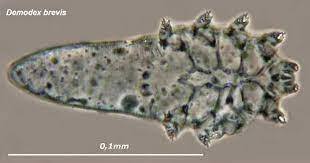
About the Author
Written by Optometrist Megan Lafferty, contact us to book an appointment with Megan.
To some people, eyelids and lashes are a proud display of beauty. We adorn them in creams, coloured powders and black ink every day and most likely (and most unfortunately) fail to clean this off properly at night which can inadvertently lead to eye irritations and infections.1 However, there is another problem you may not know about potentially already lurking on our eyelashes which can cause similar eye irritating symptoms… Demodex.

What is Demodex?
Demodex are tiny eight-legged mites which inhabit the skin and hair follicles, particularly the eyelashes, of humans and other mammals. They are more common as we age and can only be seen through microscopic examination.2 The ecosystem of our skin has many living microorganisms therefore mites such as these are not surprising, however, interest in them has grown in recent years due to their potential role in certain skin irritating conditions.3
How Demodex Affects Eyelids and Lashes
Whilst Demodex usually have a symbiotic (harmonious) relationship with our bodies, certain factors can lead to their overpopulation and potentially contribute to the development of skin issues. Demodex consume epithelial cells around hair follicles which can contribute to dandruff formation, loss of eyelashes (madarosis) or eyelash misdirection.4 As our eyelashes are thought to serve a protective function for our eyes, their loss can result in development eye infections which cause symptoms such as itching, redness, swelling and crusting of the eyelids and lashes.5
Inflammatory Conditions
Demodex can carry bacteria to the eyelids which stimulates inflammatory responses.4 Blepharitis is an common inflammatory condition heavily associated with Demodex as it also affects the eyelid margin and eyelashes and has similar symptoms. Research shows a higher incidence of Demodex in patients with Blepharitis than those without.6 Demodex mites can also block the pores of the eyelid glands which can lead to Meibomian Gland Dysfunction (MGD), linked not only to Blepharitis but also to Dry Eye.4 By clogging the eyelid’s oil producing glands, this can cause subsequent tear deficiency and induce symptoms of dryness, itching and gritty eyes.8 Another strong association between Demodex and inflammatory skin conditions is Rosacea.4
To find out more about Blepharitis please click here.
Day to Day Impact
The potential issues stemming from Demodex infestations such as dry, red, itchy eyes, can have a significant impact on day to day life, particularly for those who wear contact lenses. The most common reason patients stop wearing lenses is discomfort due to dryness.9 Although a multitude of factors can contribute to dry eye disease, one particularly relevant to Singapore is the prevalence of pathological myopia. Given that Singapore has one of the highest myopia rates globally,10 it is important to note the association with myopia and conditions like dry eye.11 Consequently, the combined impact of myopia, contact lens wear and skin conditions like demodex could exacerbate these issues leading to more eye infections and irritations here in the Lion City.
How To Treat
Demodex is a chronic condition therefore requires ongoing treatment to reduce the overpopulation of mites on the eyelids and lashes and decrease inflammation. Much like for Blepharitis, Demodex treatment involves lid scrubs, but the most established method for eradication of these mites is to use Tea Tree Oil, although total eradication is not likely.7 Some patients with sensitive skin should be cautious when using high concentrations of tea tree oil and thus should consult a professional before treating.
Conclusion
Demodex mites are a common occurrence on human skin. Not everyone experiences issues from their presence but those that do may benefit from having a better understanding of what they are, their relation to other common conditions and most importantly how to treat them. Conditions associated with Demodex such as Blepharitis and Dry Eye are more prominent now than ever.12 Comprehensive eye examinations with an eye care professional can help diagnose conditions accurately so that proper treatment and resolution can be achieved.
If you would like to book a Dry Eye Examination, please click here.
References:
- C. B. Giacomel, G. Dartora, H. S. Dienfethaeler, S. E. Haas. Investigation on the use of expired make-up and microbiological contamination of mascaras. International Journal of Cosmetic Science (2013). doi:10.1111/ics.12053 (https://onlinelibrary.wiley.com/doi/10.1111/ics.12053)
- C. W. Clifford, G. W. Fulk. Association of diabetes, lash loss, and Staphylococcus aureus with infestation of eyelids by Demodex folliculorum (Acari: Demodicidae). J Med Entomol (1990). Doi: 10.1093/jmedent/27.4.467. (https://pubmed.ncbi.nlm.nih.gov/2388222/)
- E. A. Grice and J. A. Segre. The skin microbiome. Nat Rev Microbiol (2013) doi:10.1038/nrmico2537 (https://www.ncbi.nlm.nih.gov/pmc/articles/PMC3535073/)
- J. Liu, H. Sheha, and S. C.G. Tsenga. Pathogenic role of Demodex mites in blepharitis. Curr Opin Allergy Clin Immunol (). doi:10.1097/ACI.0b013e32833df9f4. (https://www.ncbi.nlm.nih.gov/pmc/articles/PMC2946818/#R1)
- G. J. Amador, W. Mao, P. DeMercurio, C. Montero, J. Clewis, A. Alexeev, and D. L. Hu. Eyelashes divert airflow to protect the eye. J R Soc Interface (2015) doi:10.1098/rsif.2014.1294. (https://pubmed.ncbi.nlm.nih.gov/25716186/)
- M. Türk, I. Oztürk, A. G. Sener, S. Küçükbay,I. Afşar, A. Maden. Comparison of incidence of Demodex folliculorum on the eyelash follicule in normal people and blepharitis patients. Turkiye Parazitol Derg. (2007) PMID: 18224620. (https://pubmed.ncbi.nlm.nih.gov/18224620/)
- S. R. Fromstein, J. S. Harthan, J. Patel, and D. L. Opitz. Demodex blepharitis: clinical perspectives. Clin Optom (Auckl) (2018). doi: 10.2147/OPTO.S142708. (https://www.ncbi.nlm.nih.gov/pmc/articles/PMC6118860/)
- J. Singh, Y. Priya, and V. Bhat. Prevalence, Severity, and Treatment Outcomes of Meibomian Gland Dysfunction in Patients With Dry Eye Symptoms at a Tertiary Care Center in South India. Cureus (2022) doi: 10.7759/cureus.25703. (https://www.ncbi.nlm.nih.gov/pmc/articles/PMC9260487/)
- M. Markoulli and S. Kolanu. Contact lens wear and dry eyes: challenges and solutions. Clin Optom (Auckl) (2017). doi: 10.2147/OPTO.S111130. (https://www.ncbi.nlm.nih.gov/pmc/articles/PMC6095561/)
- B. A .Holden, T. R. Fricke, D. A. Wilson, M. Jong, K. S. Naidoo, P. Sankaridurg, T. Y. Wong, T. J. Naduvilath, S. Resnikoff. Global Prevalence of Myopia and High Myopia and Temporal Trends from 2000 through 2050. Epub (2016) doi:10.1016/j.ophtha.2016.01.006 (https://pubmed.ncbi.nlm.nih.gov/26875007/)
- N. Ilhan, O. Ilhan, E. A. Tuzcu, C. M. Daglioglu, M. Coskun, N. Parlakfikirer, U. Keskin. Is There a Relationship Between Pathologic Myopia and Dry Eye Syndrome? Cornea, Clinical Science (2014). doi:10.1097/ICO.0000000000000033 (https://journals.lww.com/corneajrnl/abstract/2014/02000/is_there_a_relationship_between_pathologic_myopia.12.aspx)
- L. Qian and W. Wei. Identified risk factors for dry eye syndrome: A systematic review and meta-analysis. PLoS One. (2022). doi:10.1371/journal.pone.0271267 (https://www.ncbi.nlm.nih.gov/pmc/articles/PMC9390932/)





